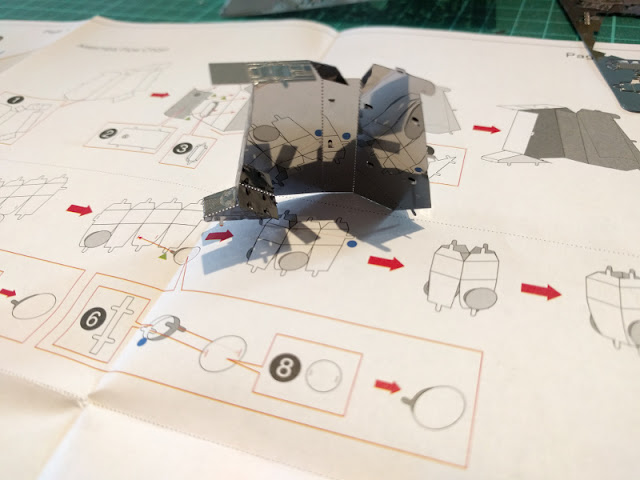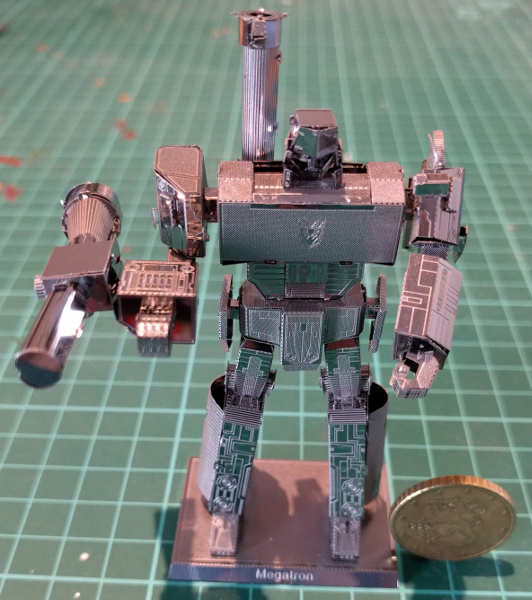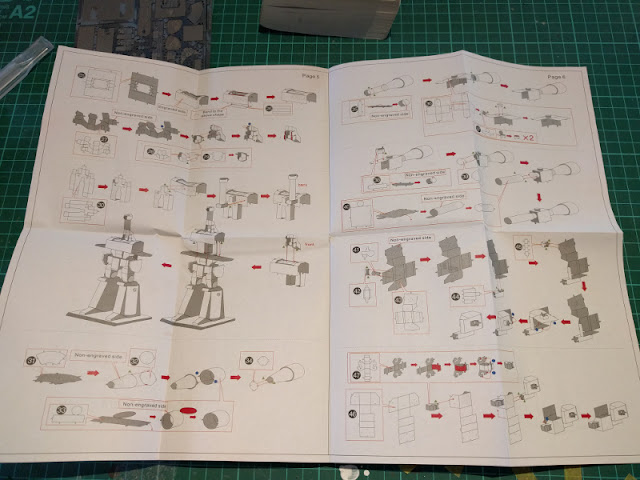The Command Module
Building the AT-ST, All-Terrain Scout Transport, also known as a scout walker among other things, was started from the command module. First a box was installed on top of the turret, then the ingress/egress hatch with its safety railing. After I had the railing properly and firmly attached I had to rebend it straight. It ended up looking battered and beaten up in action!Next I went on the right cheek and installed the first few armour plates. I really couldn't remember what the basic AT-ST looked like but this one was either a more impressive one (yes) or some sort of a modified, more heavily armored unit - or my earlier (old) AT-STs have just been that much worse on details. The latter may not be too far from the truth, I thought.
After these bits that improved the war machine's overall aesthetics I got to build the right side's gun: a concussion grenade launcher. Forming these round shapes out of flat pieces has always been somewhat challenging. I guess they worked out decently this time.
The instructions had me going around the pod counter-clockwise, so next I added some extra armour plates on the front bit. Somehow it would've been fun if the viewports could've been left open, but that's something we have to leave for a plastic model. Assuming I could find one, that is.
The left side of the command pod went just like the right one, just with a different kind of a boomstick. This hardpoint received a light twin-barreled E-Web blaster cannon. As you can see in the photo the left half was still open on purpose and was going to remain so until the last stages of building.
Hips
Next in the program was the hip setup. Assembling it by the book was a bit silly, as it'd been much easier to first install just about all the bits while the main unit was completely open and uninhibiting. Had I thought of that I'd had easier time with a couple of the pieces. At least I had had the sense to keep it that open...Of course these were just tiny complaints. The swivel bit that went between the turret and the hip unit was maybe a bit easier to build than the real one (shape-wise, that is). The double-cone was a bit tight in places and tightening the connections didn't succeed perfectly everywhere. I trusted that it'd hold together anyway.
Either I just didn't know what I was doing or there was something odd somewhere, as the attachment band on the right side of the hip forced the thigh bit into a very sharp angle when compared to the one on the right side (which was mirrored in the instructions but not in real life). As far as I could say the rounded bands were all the same, symmetrical and three-spiked and therefore they were not misaligneable. Or that's what I had thought. At this point I was, as to be expected, somewhat sceptical about the right leg's position later on.
The legs
Yeah, I had installed both the right thigh onto the hip and the rear plate of the hip unit not caring that the instructions wanted me to do that a few evenings later. While I was assembling the leg I was really concedned of accidentally bending it so badly that it wouldn't work at all a few steps later.Either it was because of the temperatures home or in the tiny and flimsy pieces but just to get the right leg built up to the progress shown in the next two photos made my fingers awfully sweaty. I had also managed to leave an obscene amount of fingerprints everywhere, so I absolutely could not avoid a cleanup when all was built.
Reaching the status shown in the next four photos took another 45-ish minutes. I guess it was because all of these tiny subassemblies, they were just incredibly time-consuming. Then again, I think it's been the most detailed MEM model I've built so far. The other (inner) half of the right leg went with the same routine as the first half, so I was confident in being much more efficient with the left leg later on.
Luckily (or skillfully?) the so-far built part of the leg got attached to its thigh without a hitch. The decorative pieces and the extra armour behaved nicely as well. Funnily enough I noticed (or recognized) the ankle-attached tendon piece only after I had attached it to the back of the leg. That's how the context was easy to lose while staring at the details.
Then the other one
After a couple of evenings off I started on the left leg. This time I knew pretty well how it was going to proceed and which pieces I'd be using. With the benefit of experience I got the leg built and attached in less than 45mins. That took way less than half of the time I had spent on the first leg.Then I did as before, attached armor plates and ankle bits. Of course things couldn't just work but the small box in the tendon piece broke in two as it was bent badly while removing it from the sprue. And the remaining bits naturally fell off thanks to the lack of support. Grumble grumble.
Back to the top
The main gun(s)
Before I could finish the command module I finally was unleashed on the chin gun (a Taim & Bak MS-4 twin blaster cannon)! Despite its slight flimsiness building it was actually lots of fun.The gun unit was installed hanging from the command pod's slightly bent bottom plate's front end. One of the barrels had got twisted a bit but it did end up looking decent after some restraightening. As long as you didn't look at it straight from the side, of course.
Sealing the backside
The command pod's rear armour plate required a couple of cooling units and whatever they were called in the specs. Especially working on the fan containers I was about to get even greyer hairs, as they were very fragile and needed to be treated very carefully. I mean, just look at them!
My final curses
Apparently these kits just have to have something that just have to require crying and tooth-grinding. In the AT-ST's case that part was when you attach the command pod into its own floor. I admit that at one point I felt like throwing the model out of the window and with all the power I could muster.After taking a couple of deep breaths and calming down a bit I got it all done. From that moment on the project just couldn't fail anymore by accident. I inserted the walker's ankles into the baseplate and to my great surprise the uninstructed pose didn't end up being problematic at all. That was just nice.
Now that my war machine was standing on its leg stumps I had to attach the foot pads with their toes on the rest. This proved surprisingly complicated as the foot pads had a most peculiar shape. I almost broke off one of the toe units, so flimsy they were. Still, nothing broke anymore and I got all the last bits installed without incidents.
Hey, look at that: it looks like an AT-ST! Now I was content.











































































